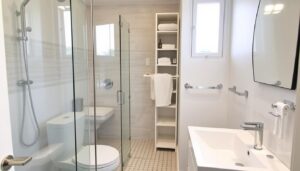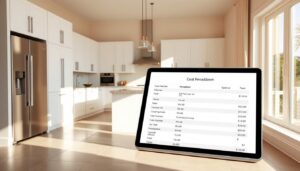Upgrading your cooking space can transform both its functionality and appeal. In the UK, a well-planned renovation adds significant value to your property while enhancing daily living. Whether you’re dreaming of sleek modern units or a cosy traditional look, knowing the expenses involved helps avoid surprises.
Prices vary widely based on project scope, materials, and labour. Smaller updates may start from £5,000, while full overhauls can exceed £35,000. The Royal Institution of Chartered Surveyors (RICS) notes rising costs, making careful budgeting essential.
This guide breaks down key factors influencing expenses—from layout changes to appliance choices. You’ll also find smart tips to balance quality and affordability without compromising on style.
Key Takeaways
- Renovating boosts property value and improves usability.
- Costs range from £5,000 to £35,000 depending on scale.
- Material selection and labour significantly impact budgets.
- Strategic planning prevents overspending.
- RICS data highlights increasing renovation expenses.
Understanding Kitchen Renovation Costs in the UK
Transforming your cooking area involves careful budgeting to match your vision. Prices fluctuate based on the scale of changes, from cosmetic tweaks to complete overhauls. Recent data from CheckATrade and RICS shows regional disparities, with London and the Southeast commanding higher rates.
Average Costs for Different Renovation Scales
A budget refresh (£4,000–£8,000) suits small spaces with standard units and laminate worktops. Mid-range projects (£8,000–£15,000) often include solid wood cabinets and integrated appliances. For a luxury overhaul (£15,000–£30,000+), expect bespoke designs and premium finishes.
Real-world examples:
- A 10m² space with stock units: £6,500–£9,000
- A 20m² kitchen with custom cabinetry: £18,000–£25,000
Factors Influencing the Total Cost
Size directly impacts expenses—larger spaces need more materials and labour hours. Cabinets alone account for 30–40% of budgets, with stock options (£800–£5,000) costing less than custom builds (£2,000–£15,000).
Hidden considerations:
- Structural adjustments (e.g., removing walls)
- Upgraded plumbing or electrical systems
- Regional labour rates (20% higher in urban centres)
An efficient layout minimises wasted space, while complex designs may require professional planning fees. Always factor in a 10–15% contingency for unexpected costs.
How Much Is a Kitchen Renovation UK? Breaking Down the Expenses
Breaking down expenses helps homeowners allocate budgets effectively for a seamless upgrade. Labour and material costs typically account for 70–80% of total spending, with the rest covering design, permits, and contingencies.
Labour Costs: What to Expect
Contractor fees range from £1,500 to £5,000, depending on project complexity. Specialist trades add to this:
| Trade | Average Cost |
|---|---|
| Electricians | £300–£1,500 |
| Plumbers | £400–£2,000 |
| Joiners | £1,000–£4,000 |
Remember, VAT at 20% applies to professional services. Skip hire for waste removal adds £200–£400, often overlooked in initial quotes.
Material Costs: Cabinets, Worktops, and More
Cabinets dominate budgets, with laminate options starting at £800 and bespoke designs reaching £15,000. Worktops vary widely:
- Laminate: £500–£1,500
- Quartz: £2,000–£5,000
For appliances, integrated models cost 20–30% more than freestanding ones. A £20,000 project might split £12,000 for materials and £8,000 for labour.
“Always request itemised quotes to compare like-for-like services and avoid hidden charges.”
Budgeting for Your Kitchen Renovation
Smart budgeting ensures your project stays on track without compromising quality. Start by listing priorities—whether it’s premium appliances or a layout overhaul—and allocate funds accordingly. Experts recommend a 10–15% contingency for surprises like damp proofing or rewiring.
Setting a Realistic Budget
Divide your budget into categories for clarity:
- Labour (40–50%): Includes tradespeople like electricians and plumbers.
- Materials (30–40%): Cabinets, worktops, and flooring.
- Contingency (10–15%): Covers unforeseen issues like asbestos removal.
Compare quotes for plumbing and electrical work—prices vary by region. Seasonal sales on appliances can save up to 50%.
Hidden Costs to Watch Out For
Common oversights include:
- Planning permissions: Required for structural changes.
- Waste disposal: Skip hire adds £200–£400.
- Small updates: New handles or doors refresh cabinets for less.
“Track every expense with a spreadsheet—it’s the best way to avoid blowing your budget.”
Financing options like home improvement loans spread costs, but paying upfront saves money on interest. Refacing cabinets costs 50% less than replacements, offering a stylish compromise.
Design and Planning Your Dream Kitchen
Creating your ideal cooking space starts with thoughtful design and smart planning. Whether you prefer sleek minimalism or rustic charm, every choice—from cabinetry to lighting—shapes both style and functionality.

Custom vs. Stock Cabinets: Making the Right Choice
Stock cabinets offer affordability and quick delivery (2–3 weeks), but limited sizes and finishes. Custom options (8–12 weeks) provide tailored solutions for awkward space, though at a higher cost.
Material matters:
- MDF: Budget-friendly, paintable, but less durable.
- Solid wood: Timeless appeal, withstands wear.
- Thermofoil: Moisture-resistant, ideal for busy households.
Kitchen Islands: More Than Extra Counter Space
An island (£700–£4,000) can transform your layout, adding storage, seating, or even a sink. For small kitchens, compact designs with fold-down sides maximise utility without crowding.
“Always measure your floorplan—islands need at least 1m clearance around them for smooth traffic flow.”
Lighting enhances both style and practicality. LED strips under cabinets illuminate worktops, while pendant lights over islands create a focal point. For galley kitchens, mirrored backsplashes visually expand the space.
Labour and Professional Services
Choosing between professional help and DIY can make or break your renovation. Labour costs often consume half the budget, so picking the right approach saves time and stress. Whether you hire experts or tackle tasks yourself depends on skills, project scope, and safety needs.
Hiring a Professional Contractor vs. DIY
DIY cuts labour costs by 40–50%, but some work demands certification. Painting or tiling suits DIY, while gas and electrical jobs legally require professionals. Here’s a quick comparison:
| Task | DIY Cost | Professional Cost |
|---|---|---|
| Cabinet Installation | £0 (if skilled) | £1,500–£3,000 |
| Tiling | £200–£500 | £800–£2,000 |
| Gas Hob Fitting | Not advised | £300–£600 |
Always check credentials like Gas Safe or NICEIC for tradespeople. Uncertified work risks safety and invalidates insurance.
Understanding Installation Costs
Professional installations take 2–6 weeks, while DIY stretches longer. Managed services include warranties, but self-managing offers more options. Key considerations:
- Building Regulations: Structural changes need approval.
- Vetting Contractors: Check reviews, insurance, and past project photos.
- Timelines: Refacing cabinets takes 1–2 weeks; full remodels 4+ weeks.
“Hire specialists for technical tasks—saving pennies isn’t worth risking your home’s safety.”
For complex jobs, project managers coordinate trades, ensuring seamless progress. Allocate 10% extra for unexpected delays or additional time.
Materials and Appliances: Where to Spend and Save
Selecting the right materials and appliances can make or break your kitchen’s look and functionality. From durable worktops to energy-efficient gadgets, every choice impacts both aesthetics and long-term costs. Prioritising quality where it matters ensures a space that’s stylish and practical.
High-End vs. Budget Appliances
Premium appliances often last 10–15 years, compared to 5–8 for budget models. Splurging on a reliable oven or fridge makes sense, while a basic microwave can save pounds. Energy ratings (A+++ to D) also affect running costs—higher grades cut bills over time.
Smart tech, like Wi-Fi-enabled fridges, adds convenience but bumps prices by 20–30%. For smaller budgets, focus on core appliances and skip extras like wine coolers. A mid-range dishwasher (£400–£700) balances performance and affordability.
Flooring and Backsplash Options
Flooring costs range from £20/m² for vinyl to £100/m² for hardwood. Porcelain tiles (£30–£60/m²) resist scratches, ideal for busy homes. Bamboo offers eco-friendly durability, while laminate mimics pricier woods for less.
Backsplashes protect walls and add flair. Ceramic tiles (£400–£1,200) are budget-friendly, while glass or metal designs (£1,000–£2,000) create a sleek look. Recycled glass tiles combine sustainability with unique patterns.
“Invest in resilient surfaces like quartz worktops—they withstand daily wear and boost resale value.”
Maintenance matters: Sealed stone resists stains, while porous materials like marble need yearly treatment. For flooring, vinyl planks are waterproof and easy to clean—perfect for families.
Tips to Save Money on Your Kitchen Renovation
Smart homeowners know that strategic choices can slash renovation expenses without sacrificing style. Whether refreshing a compact galley or overhauling a large family space, these practical approaches keep your project affordable.
Refacing Versus Replacing Cabinets
Giving your kitchen units a facelift costs 30-50% less than full replacements. Specialist services like Kitchen Magic refresh tired doors and drawer fronts while keeping existing frames. Here’s how it works:
- Measure existing cabinet dimensions precisely
- Choose new door styles from laminate to solid wood
- Opt for soft-close hinges to modernise functionality
- Consider vinyl wraps for damaged surfaces
For partial updates, replacing just the doors creates dramatic change. Charity shops often accept old units, potentially qualifying for tax deductions at your home.
Smart Shopping Strategies
Timing purchases right can halve your appliance costs. January sales and Black Friday see premium brands discounted by 40-50%. Ex-display models offer similar savings year-round.
| Savings Tip | Potential Reduction |
|---|---|
| Remnant stone worktops | 30-60% off |
| Open-box appliances | 20-40% off |
| Bulk buy discounts | 10-15% off |
Integrated appliance panels disguise standard models as bespoke units. Community reuse schemes provide quality second-hand kitchen units, while energy-efficient upgrades may qualify for government incentives.
“Always ask showrooms about price matching—many will beat competitors’ offers by 5-10% to secure your business.”
With these approaches, you can achieve a magazine-worthy space today while keeping more money in your pocket. Focus savings on areas with high visual impact for maximum effect.
Conclusion
A well-planned upgrade transforms your space into a dream kitchen, boosting both daily enjoyment and property value. Focus on quality installations—they pay off in durability and resale potential.
For tight budgets, consider phased updates. Start with essential fixes, then add stylish touches later. Always set aside 10-15% for unexpected costs—this safeguards your investment.
Seek professional advice for complex tasks. Certified tradespeople ensure safety and compliance, saving money long-term. Small details, like energy-efficient lighting, enhance functionality without big spending.
Your project’s end result should balance beauty and practicality. With smart choices, you’ll create a space that works hard and looks stunning for years.
FAQ
What’s the average cost of a kitchen renovation in the UK?
Prices vary widely, but a mid-range makeover typically costs between £8,000 and £15,000. High-end projects can exceed £25,000, while budget-friendly updates start around £5,000.
How much should I budget for labour?
Labour usually makes up 30-40% of the total cost. Expect to pay £150–£250 per day for skilled tradespeople like plumbers and electricians.
Are custom cabinets worth the extra expense?
Custom cabinetry offers a perfect fit and unique design but costs 20-30% more than stock units. Consider them if layout flexibility or premium materials matter most.
Can I save money by keeping my existing layout?
Yes. Moving plumbing or gas lines adds significant expense. Updating appliances, worktops, and cabinet doors within the current footprint cuts costs.
What’s cheaper: refacing or replacing cabinets?
Refacing doors and replacing handles costs 50-70% less than new cabinetry. It’s ideal if the frames are in good condition but the style feels outdated.
How do appliance choices impact the budget?
Opting for mid-range brands like Bosch or Samsung balances quality and cost. Luxury brands (e.g., Miele) can double appliance expenses.
Should I include a kitchen island in my design?
Islands add prep space and storage but require at least 10 sqm of floor area. Budget an extra £1,500–£5,000 depending on materials and features.
What hidden costs should I anticipate?
Unexpected structural issues, waste removal, or premium finishes (e.g., quartz worktops) often increase the final bill by 10-15%.






